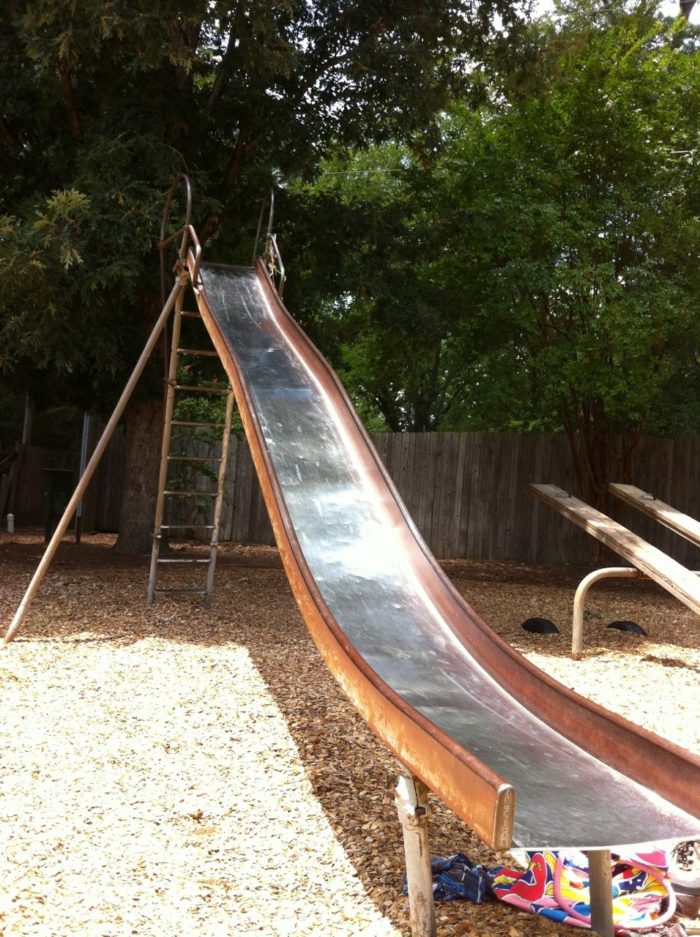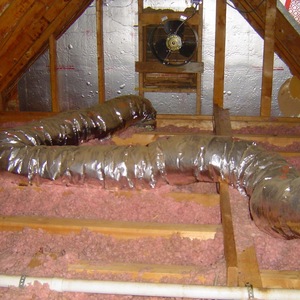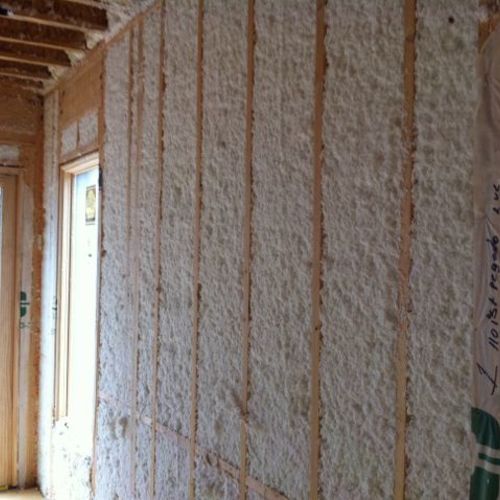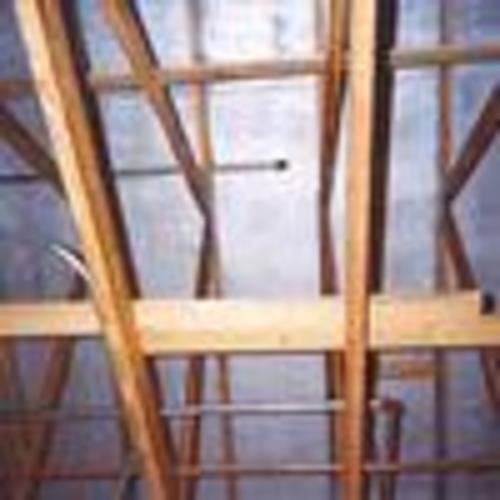Image Credit: Energy Vanguard
Image Credit: Energy Vanguard Radiant barrier roof decking reduces the amount of heat from the roof that radiates into the attic.
Image Credit: Energy Vanguard Figure 1: Diagram of heat flow through a roof without a radiant barrier
Image Credit: Energy Vanguard Figure 2: Diagram of heat flow through a roof that does have a radiant barrier
Image Credit: Energy Vanguard
Today just feels like a good day to talk about shiny stuff. Radiant barriers are a green building product with a lot of sex appeal, if that’s possible for construction products. People get really crazy about attics, though. (Don’t get me started about powered attic ventilators!) Maybe brains have a tendency to overheat when discussing them. The general category of radiant barriers is an area of great hype and misunderstanding, so I’ll tell you what I know, explain the basic physics, and give you a couple of links to some great resources for more information.
OK, first of all, a radiant barrier is something that can keep your attic cooler. Unlike powered attic ventilators, they actually go after the source of the problem rather than treating a symptom — but first, let’s look at the physics.
Attics get hot because the sun is beating down on them all day. The heat from the sun comes in the form of electromagnetic radiation. When this radiation hits a surface, it can do one of three things: It can be (i) reflected, (ii) transmitted, or (iii) absorbed. How much of each you get depends on the wavelength of the radiation and the properties of the material it hits.
The heat is conducted from the shingles to the sheathing
The part we’re concerned with here is the sunlight that’s absorbed by your roof. Once the roof sucks up those rays, it gets hot. That heat at the absorbing surface (shingles on most residential roofs) then does what the Second Law of Thermodynamics tells it to do — it looks for cooler places, so it starts conducting down through the roofing materials. When it finds the underside of the roof deck, it then can radiate down into the attic. Typical roof decking materials — plywood and oriented-strand board (OSB) – are pretty good radiators, so everything they “see” in the attic starts getting hot, too.
Here is the basic process of heat transfer:
- Radiation hits the roof.
- The radiant energy is absorbed by the roofing materials.
- The thermal energy conducts downward.
- Heat radiates from the roof deck to everthing in the attic.
The heat radiates into the attic from the underside of the sheathing
So, the dominant form of heat gain in an attic is from radiation, which heats up all the solid materials it finds — framing, ductwork, insulation, all those boxes of Christmas decorations, and dead squirrels. That’s one reason powered attic ventilators aren’t a good solution. They’re going after the air, but the air is hot only because all the solid materials are hot.
A better way to reduce the attic temperature is to go after the source — the radiation constantly blasting the attic from the bottom of the roof deck and rafters. Plywood and OSB are good radiators. In physics language, they have high emissivity, which means they’re good at emitting radiant energy.
That’s where radiant barriers come in. These are materials that have a low emissivity. When the underside of the roof deck has a radiant barrier installed, the heat still travels through the materials, but once it hits the radiant barrier, it’s come to a dead end. Little of that heat then radiates to the attic.
The radiant barrier gets hot. If you go up into the attic and touch it, you’ll see that the heat’s still getting there. But like that stainless-steel playground slide shown at the top of this article, when you hold your hand near it without touching, it doesn’t feel like it’s hot. The magic of low emissivity!
Radiant barriers need an air gap
In case you’re wondering, the answer is yes, this is the same thing that makes low-e windows so good. Also, if you’re wondering how hot the shingles get, the Florida Solar Energy Center has done research on that, which I wrote about a while back.
OK, so if the radiant barrier doesn’t feel hot when you hold your hand an inch away but it can burn you when you touch it, what does that mean for installation? You got it! You have to have an air gap next to the radiant barrier. If you spray foam insulation right on the radiant barrier, you’ve wasted your money on the radiant barrier. Heat will conduct right through the radiant barrier because generally, materials with low emissivity have high conductivity.
More resources
There’s so much more to say about radiant barriers, but let me wrap up this article and give you a couple of resources where you can read more about how they work, how to install them, how much they might save, and why you probably don’t want to install one in Pennsylvania or other cold-climate locations. The first is the Florida Solar Energy Center (FSEC). They have a bit of radiant heat gain in attics down there and know a thing or two about this topic. Here’s a good Question and Answer Primer that’s got a lot of good info.
Oak Ridge National Laboratory, which does a lot of great building science research, has several good pages about radiant barriers, too.
Another great study is the Houston Home Energy Efficiency Study (pdf). This was a study done by Michael Blasnik and Advanced Energy, and among other things, they looked at the cost-effectiveness of radiant barriers. What they found was that in Houston, Texas, radiant barriers reduced the cooling consumption by about 3%. The paper is well worth the read, in case you don’t already have a copy. (Oh, yeah…it’s free!)
Finally, here are a couple of good resources that address the question of if or when you should install a radiant barrier. Martin Holladay wrote Radiant Barriers: A Solution in Search of a Problem a couple of years ago here at Green Building Advisor and included a lot of great info on the topic. Also, a new website called Radiant Barrier Truth tackles the issue of radiant barriers in cold climates.
I’ll come back to this topic and write more another time, but for now, let’s not forget what my friend Mike Barcik says is one of the most appealing features of radiant barriers: People like shiny stuff!
_________________________________________________________________________
Allison A. Bailes III, PhD is a speaker, writer, building science consultant, and the founder of Energy Vanguard in Decatur, Georgia. He has a doctorate in physics and writes the Energy Vanguard Blog. He also has a book on building science coming out in the summer of 2022. You can follow him on Twitter at @EnergyVanguard.
Weekly Newsletter
Get building science and energy efficiency advice, plus special offers, in your inbox.
















19 Comments
White Roofs
I have long been interested in this topic of radiant heat transfer, and believe it is the most fascinating and misunderstood mechanism of heat transfer.
Initially, I understood that the reflectivity and emissivity of a surface depends on surface texture and color. More recently, I have read that color plays a much smaller role than once thought, and that reflectivity and emissivity depends mostly on surface texture.
Recently, I have heard about advocacy of white roofing colors to reduce solar absorption. I have not followed this closely, so I am not sure what the roofing material would consist of, but I assume it would be a granular surface similar, if not identical to asphalt shingles. However, that would present a highly textured surface, which I would expect to be highly absorbent despite the while color. So I am wondering what the thinking is behind the suggestion of white roofs and why there seems to be a primary emphasis on color of the roofing.
I would think that white asphalt shingles would be far more absorbent than black shiny metal, for instance.
3% reduction in Houston Ron.
3% reduction in Houston Ron. Sounds like at this point your shingle color is moot.
White Roofs
Most of what I find referencing the so-called “cool roofs” associates them with the color, white. “White roof” appears to be an almost generic term synonymous with “cool roof.” Many references refer to the color white as being an essential ingredient in the cool roof function of reflecting radiant heat form the sun.
Ron,,, 3% is nothing.
Ron,,, 3% is nothing.
Question about terms
Regarding this quote from above:
"When this radiation hits a surface, it can do one of three things: It can be (i) reflected, (ii) transmitted, or (iii) absorbed. How much of each you get depends on the wavelength of the radiation and the properties of the material it hits."
What is meant by stating that radiation can be transmitted?
Response to Ron Keagle
Think of light going through glass or x-rays going through flesh or gamma rays going through most materials. That's what I meant by radiation being transmitted.
Cool roofs, colors, and emissivity
When sunlight is absorbed by the roofing the roof temperatures heat up to well over the ambient air temperature. Most of the heat is then re-radiated back at the sky in the form of deep infra-red radiation, and another significant fraction is conducted to the films of air adjacent to the roofing/shingles and convected away. (The fraction of heat removed by convection is affected by the slope of the roof and winds.) The temperature at which the shingles will stabilize is a function of several factors: The reflectivity of the roof, the infra-red emissivity of the roofing, the angle and intensity of the incident solar radiation, the average sky temperature into which the roofing is radiating it's infra-red (if the sky is hazy and reflects the heat back to the roof, the shingle temp will be higher than on a hard-blue clear-sky day.)
White roofs reflect a large fraction of visible-spectrum sunlight and usually a good fraction of the near-infra-red and near-ultraviolet portion of the solar spectrum, and peak shingle temperatures will usually be at most a few tens of degrees above the ambient air temp. But if the infra-red emissivity is too low (as with some aluminum coatings) the reduction in the ability to radiation-cool can result in a high temp despite being highly reflective across the solar spectrum. There are many non-white cool roof materials over a wide range of colors that absorb some of the visible spectrum resulting in it's characteristic color but still reasonably reflective in non-visible regions of the solar spectrum, with sufficiently high IR emissivity to achieve quite low peak temps relative to the ambient air.
A lot of work on heat-rejecting roofing has been done on this over the past 2 decades at the Lawrence-Berkeley National Laboratory, a brochure-length no-math condensed version of which lives here:
http://heatisland.lbl.gov/sites/heatisland.lbl.gov/files/Beyond%20White%20-%20Advances%20in%20cool%20colors%20Brochure.pdf
(There is a huge body of related material on the LBNL websites, if you really want all of the details.)
But there's much more to heat rejecting roofing than merely "white".
Cool roof finishes are at least as effective at reducing cooling load as radiant barrier, and since there is little or no cost-premium, it's far more cost effective.
Dana... blah blah blah... 3%
Dana... blah blah blah... 3% period. Who cares.
...
...
Response to aj: YOU care! (or at least you should.)
The state of California cares, and has incorporated it into their Title 24 energy code standards.
Yes it's only a low single-digit percentage reduction in total cooling power use, but it is essentially a FREE performance upgrade when incorporated at the time of re-roofing or new construction. It's only a few percent change in the total cooling energy use, but the reduction on the PEAK power grid load is at least 3x that, reducing the transmission grid size requirements as well as peak power generation capacity requirements.
Though from a dumb fixed-rate residential customer point of view it may appear to be no BFD, it's much bigger than meets the eye in terms of keeping the overall electricity rates lower. You may care, but you should: The wholesale price of peak power paid by the utility is typically more than 2x the residential retail fixed rate, and those very real costs get averaged into the fixed rate- nothing is free.
Pardon me, AH, but...
AJ: Despite all the radiant barrier talk, I find myself steaming. The blog is on radiant barriers and the questions are on cool roofs, but you seem to be stuck on the 3% reduction in heat loads provided by radiant barrier sheathing, something that has little to do with radiant barriers (since the reflective layer is adhered to the roof sheathing, thus obviating its effectiveness) and NOTHING to do with cool roofs.
According to http://www.ornl.gov/sci/btc/pdfs/env_cool_roofs_fs_apr07.pdf, changing from a black shingle to a white one can reduce heat absorption by the roof from over 90% to less than 20%.
According to http://cbpd.arc.cmu.edu/ebids/images/group/cases/site.pdf, cool roofs reduce cooling loads by about 50%.
But Dustin...
Your second link shows mere single-digit percentage reductions in cooling power use, which is in the same range as what you get with radiant barriers. (Are you REALLY going to argue that 3.95% or 4.12% savings is dramatically different from the 3% savings of the single-location radiant barrier case that was cited?) The flat-roof retail buildings will always see much higher savings than even modest-angle residential roofing, which skews their numbers to hit the "11% average". Those same flat-roof buildings would see much higher reductions than 3% for power use using radiant barriers too, and radiant barrier is considered an acceptable alternative (although a more expensive alternative) to cool-roofs under CA Title 24 as well.
But that document also shows the reduction in peak cooling loads to be well into double-digits, which is what really matters from a public policy and code point of view. In some residential buildings that would make a case for reduced compressor sizing as well, for a net total-cost savings, if the designers simulate & optimize well, but the real savings is to the grid infrastructure and grid operating cost rather than the direct reduction in kwh/CDD to the building owner. Those very real savings to the user are more hidden since they're embedded in the power rates.
White Roof vs Radiant Barrier under the roof
I live in Key West, FL where the sun shines a bit. Most roofs in Old Town are galvinized or galvalume v-crimp metal. They have moderately high reflectivity, but very low emissivity and therefore get so hot you cannot place the palm of your hand on them during the heat of the day. Hence the term "cat on a hot tin roof". Much of that heat gets absorbed into the roof structure and radiated into your attic and on into your home. A radiant barrier certainly helps, but why let the heat into the structure in the first place. A simple coat of white house paint (or better yet, factory white metal panels) dramatically increases the emissivity and also raises the reflectivity making the roofing so much cooler you can lay naked on it in the middle of the day. I did.
White asphalt shingles also have poor emissivity and therefore are not cool materials.
Years ago I properly installed a radiant barrier in my attic and saw no noticable temperature reductions and could still feel radiant heat pouring off the ceiling sheetrock after sunset. After painting the roof white the ceiling no longer radiated heat in the evenings. I then removed the radiant barrier and cellulose insullation and spray foamed the roof deck to bring the AC ducts into the conditioned space. It now feels like we are living under an oak tree.
In my opinion nothing beats a white roof as your first line of defense in a hot climate. The other newer cool colored roofing meets the standard but is still not as good as white.
References:
- Oak Ridge National Laboratories; Thermal Emmitance Study for the State of CA
- Florida Solar Energy Center; One Year Study on medium Sloped Roof Test Building
- Australian Energy Efficiency Group; http://www.house-energy.com
" by aj builder, Upstate NY
" by aj builder, Upstate NY Zone 6a
Dana... blah blah blah... 3% period. Who cares. "
Congratulations on the most unprofessional behavior on GBA I've seen.
3% no way.
More like 15-25% effective reduction in cooling costs. I just happen to have first hand experience with a property in central Florida nearby that of controlled study a number of years ago. Years before our property was re-done with the whitest shingles available and the flat roof extension went from grey that burned skin & melted footwear to walking barefoot in the heat of the day with two coats of white elastomeric coating. Results were immediately noticeable.
Response to Ice Rabbit
Ice,
It's common for radiant-barrier salespeople to quote percentages similar to the ones you quote (for example, the claim that the installation of a radiant barrier can reduce cooling costs by 15% to 20%).
Fortunately, we can turn to government laboratories if we want data that are backed up by actual studies.
As I wrote in my article, Radiant Barriers: A Solution in Search of a Problem:
"According to a research report published by Oak Ridge National Laboratory, “The tests to date have shown that in attics with R-19 insulation, radiant barriers can reduce summer ceiling heat gains by about 16 to 42 percent compared to an attic with the same insulation level and no radiant barrier. These figures are for the average reduction in heat flow through the insulation path. They do not include effects of heat flow through the framing members. … THIS DOES NOT MEAN THAT A 16 TO 42 PERCENT SAVINGS IN UTILITY BILLS CAN BE EXPECTED. Since the ceiling heat gains represent about 15 to 25 percent of the total cooling load on the house, a radiant barrier would be expected to reduce the space cooling portion of summer utility bills by less than 15 to 25 percent. Multiplying this percentage (15 to 25 percent) by the percentage reduction in ceiling heat flow (16 to 42 percent) would result in a 2 to 10 percent reduction in the cooling portion of summer utility bills.”
"That’s the bottom line — a 2% to 10% reduction in the cooling portion of your summer electric bill. (Obviously, that’s less than a 2% to 10% reduction in your summer electric bill.)
"However, notice that these figures were calculated for a very poorly insulated attic — one with R-19 fiberglass batts. Even in Florida, it’s now illegal to build a house with such a poorly insulated attic. If you have a code-compliant home in Florida, you should have R-30 attic insulation."
Completely true, Martin
Of
Completely true, Martin
Of course it all depends on one's geographical location and the type of building and how it is constructed.
Florida is like summer year round compared to most areas. I would easily say that AC represents the bulk of our electric use in Florida. A lot of houses are single story with hip roofs, which means they have a large amount of roof space and a vast amount of ceiling space; compared to the average two story house with a smaller amount of roof & attic ceiling.
The combination of white roof that reduces radiant transmission and proper venting (we upgraded to thermostatically controlled power vents) makes a huge difference. I don't have any numbers to back it up, but the Florida Solar Energy Center looked into it with 6 identical houses that had different roof construction.
http://www.fsec.ucf.edu/en/publications/html/fsec-cr-1220-00/
( I thought they did this in Lakeland, but maybe that was a different study )
Good point regarding the attic insulation. I think we have 10" of blown in insulation (my upgrade) under a hip roof attic. Hard to add more as planking was added to provide usable storage space.
In my personal experience radiant barriers do also help in the winter time in New England. Again anecdotal, but a couple spaces I have insulated and added a single layer reflective barrier went from freezing cold, impossible to keep warm to super comfortable. %-wise how much of a difference the barrier made, compared to insulating right? I have no idea. I just know that I turned a house that was otherwise a heating nightmare into an easy to heat comfy house. By the way. Its uninsulated twin house sits across the driveway on the next lot over. They need to fill up the heating oil tank every two weeks or risk running out of oil. We need only need one tank of oil. Too many variables to count, but the combined effect of all upgrades can't be denied.
The ice rabbit. Now I like
The ice rabbit. Now I like that moniker.
Blah blah blah, I'll stick with science. Definitely regional and personal. This non rabbit lives happily with no AC and an onyx roof.
Fun thread IMO, even brought out an ice rabbit from his wabbitt hole.
Link to Houston Home Efficiency Study dead
But I found the study at:
http://www.resnet.us/blog/wp-content/uploads/2012/08/Houston-Energy-Efficiency-Study-2009-Final.pdf
Response to Jonathan Beers
Jonathan,
Thanks. I have corrected the dead link.
Log in or create an account to post a comment.
Sign up Log in